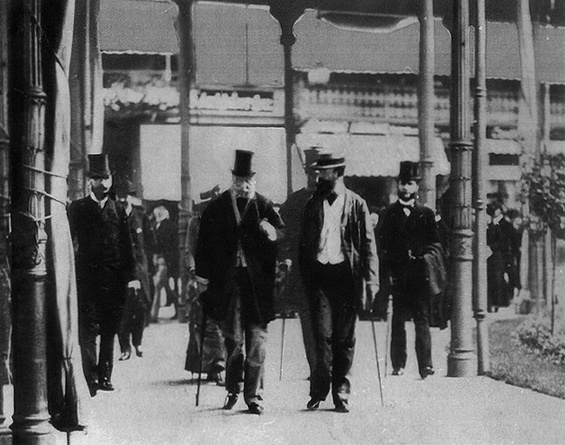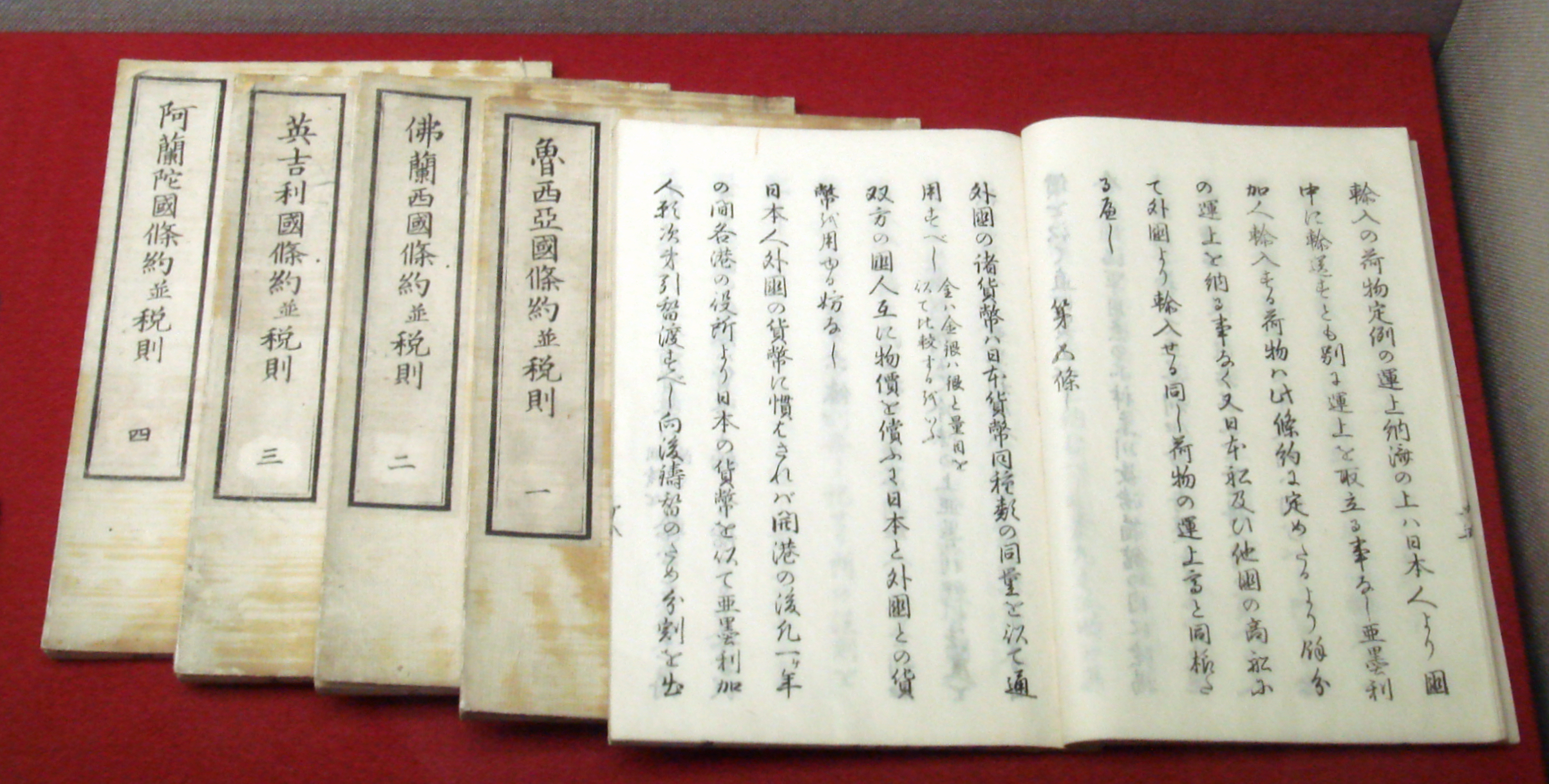|
Henry Heusken
Hendrick Conrad Joannes Heusken (January 20, 1832 – January 16, 1861) was a Dutch-American interpreter for the first United States, American consulate in Japan, established at Gyokusen-ji in Shimoda, Shizuoka in the late Bakumatsu period. He played an important role in the negotiations for the Treaty of Amity and Commerce (United States–Japan), "Harris Treaty", which opened commercial relations between Japan and the United States, and his assassination caused a minor diplomatic crisis between Japan and the various Western powers. Early life Heusken was born in Amsterdam to Joannes Franciscus Heusken, a merchant, and T. F. Smit. Heusken was their only child, he was sent to a boarding school in Province of Brabant, Brabant until age 15 and planned to go into business under his father's guidance thereafter. However, Joannes soon died, leaving the family business in disarray. Seeking an alternate path to success, and enamored with travel, Heusken emigrated to the United States in ... [...More Info...] [...Related Items...] OR: [Wikipedia] [Google] [Baidu] |
Frank Leslie's Illustrated Newspaper
''Frank Leslie's Illustrated Newspaper'', later renamed ''Leslie's Weekly'', was an American illustrated literary and news magazine founded in 1855 and published until 1922. It was one of several magazines started by publisher and illustrator Frank Leslie. Throughout its existence, the weekly provided illustrations and reports—with wood engravings, lithographs and steel engravings based on sketches and photography, beginning with daguerreotypes and later with more advanced forms of photography—of wars from John Brown's raid at Harpers Ferry and the Civil War to the Spanish–American War and the First World War - and numerous other articles of topical interest. Surviving issues today are prized by collectors for their vividly depicting American life during the seven decades of its existence. Many distinguished writers were featured in its pages. History Background Frank Leslie was the pen name of Henry Carter (1821–1880), the son of a well-to-do English glovemaker. ... [...More Info...] [...Related Items...] OR: [Wikipedia] [Google] [Baidu] |
Bowring Treaty
The Bowring Treaty was a treaty signed between the United Kingdom and the Kingdom of Siam on 18 April 1855. The treaty had the primary effect of liberalising foreign trade in Siam, and was signed by five Siamese plenipotentiaries (amongst them Wongsa Dhiraj Snid, one of the King's half-brothers) and Sir John Bowring, the British envoy and colonial governor of Hong Kong. Background The Burney Treaty had been signed between the Kingdom of Siam and the British Empire in 1826, coming about as a result of the two powers having a mutual opposition to the Ava Kingdom. That treaty had failed to settle commercial issues, leading to the arrival of Sir John Bowring to Siam in order to negotiate a new one. The treaty negotiated by him allowed free trade by foreign merchants in Bangkok, as all foreign trade had previously been subject to heavy taxation by the Siamese Crown. The treaty also allowed the establishment of a British consulate in Bangkok and guaranteed its full extraterrit ... [...More Info...] [...Related Items...] OR: [Wikipedia] [Google] [Baidu] |
Satsuma Domain
The , briefly known as the , was a Han system, domain (''han'') of the Tokugawa shogunate of Japan during the Edo period from 1600 to 1871. The Satsuma Domain was based at Kagoshima Castle in Satsuma Province, the core of the modern city of Kagoshima, located in the south of the island of Kyushu. The Satsuma Domain was ruled for its existence by the ''Tozama daimyō, Tozama'' ''daimyō'' of the Shimazu clan, who had ruled the Kagoshima area since the 1200s, and covered territory in the Provinces of Japan, provinces of Satsuma, Ōsumi Province, Ōsumi and Hyūga Province, Hyūga. The Satsuma Domain was assessed under the ''Kokudaka'' system and its value peaked at 770,000 ''koku'', the second-highest domain in Japan after the Kaga Domain.Conrad Totman, Totman, Conrad. (1993) ''Early Modern Japan'', p. 119 The Satsuma Domain was one of the most powerful and prominent of Japan's domains during the Edo period, conquering the Ryukyu Kingdom as a vassal state after the invasion of ... [...More Info...] [...Related Items...] OR: [Wikipedia] [Google] [Baidu] |
Shishi (Japan)
, sometimes known as , were a group of Japanese political activists of the late Edo period. While it is usually applied to the samurai primarily from the southwestern clans of Satsuma, Chōshū, and Tosa, the term ''shishi'' is also used by some with reference to supporters of the shogunate, such as the '' Shinsengumi''. There were many different varieties of ''shishi''. Some, such as the assassins Kawakami Gensai, Nakamura Hanjirō, Okada Izō, and Tanaka Shinbei, opted for a more violent approach in asserting their views. Kawakami Gensai, in particular, is recalled as the assassin of Sakuma Shōzan, a renowned pro-Western thinker of the time. Several assaults on westerners in Japan have been attributed to the ''shishi'' and associated ''rōnin'' warriors. In a 2013 article, these assassins have been called "early terrorists" () since they opted to spread terror among the foreigners. Other more radical ''shishi'', such as Miyabe Teizō, plotted large-scale attacks wit ... [...More Info...] [...Related Items...] OR: [Wikipedia] [Google] [Baidu] |
Prussia
Prussia (; ; Old Prussian: ''Prūsija'') was a Germans, German state centred on the North European Plain that originated from the 1525 secularization of the Prussia (region), Prussian part of the State of the Teutonic Order. For centuries, the House of Hohenzollern ruled Prussia, expanding its size with the Prussian Army. Prussia, with its capital at Königsberg and then, when it became the Kingdom of Prussia in 1701, History of Berlin, Berlin, decisively shaped the history of Germany. Prussia formed the German Empire when it united the German states in 1871. It was ''de facto'' dissolved by 1932 Prussian coup d'état, an emergency decree transferring powers of the Prussian government to German Chancellor Franz von Papen in 1932 and ''de jure'' by Abolition of Prussia, an Allied decree in 1947. The name ''Prussia'' derives from the Old Prussians who were conquered by the Teutonic Knightsan organized Catholic medieval Military order (religious society), military order of Pru ... [...More Info...] [...Related Items...] OR: [Wikipedia] [Google] [Baidu] |
Eulenburg Expedition
The Eulenburg expedition was a diplomatic mission conducted by Friedrich Albrecht zu Eulenburg on behalf of Prussia and the German Customs Union in 1859–1862. Its aim was to establish diplomatic and commercial relations with China, Japan and Siam. Background In 1859, Wilhelm I, Prince Wiilhelm of Prussia, who was acting as regent for his seriously ill brother Friedrich Wilhelm IV, appointed Friedrich Albrecht Count of Eulenburg Extraordinary Envoy to a Prussian Mission to Eastern Asia. The major participants of the expedition were Friedrich Albrecht zu Eulenburg, Lucius von Ballhausen (doctor), Max von Brandt (attaché), Wilhelm Heine (painter), Albert Berg (artist), Albert Berg (artist), Hinrik Sundewall (squadron commander) Karl Eduard Heusner, Fritz von Hollmann, Reinhold von Werner, Ferdinand von Richthofen and Gustav Spiess. The expedition was provided with three warships: , , and , along with the merchant vessel ''Elbe'', which the navy purchased to support the squadron. ... [...More Info...] [...Related Items...] OR: [Wikipedia] [Google] [Baidu] |
Friedrich Albrecht Zu Eulenburg
Count Friedrich Albrecht zu Eulenburg (29 June 1815 – 2 June 1881) was a Prussian diplomat and politician. He led the Eulenburg Expedition and secured the Prusso-Japanese Treaty of 24 January 1861, which was similar to other unequal treaties that European powers held Eastern Countries to. By Christian W. Spang, Rolf-Harald. Wippich, p. 1 Biography Eulenburg was born in Königsberg. He was the oldest surviving child of Friedrich Leopold Graf zu Eulenburg ( Prassen, 26 December 1787 - |
Dirk De Graeff Van Polsbroek
Jhr. Dirk de Graeff van Polsbroek (born ''Dirk de Graeff''; named also ''Van Polsbroek'' or ''Polsbroek'') (Amsterdam, 28 August 1833 – 27 June 1916, The Hague) was a Dutch aristocrat, merchant and diplomat. Between 1863 and 1868 he was Dutch Consul (representative), Consul General and then until 1870 Dutch Resident minister, Minister-Resident and de facto Envoy (title), envoy to Japan. Since no ambassadors were planned at that time, his legation fulfilled the same task. De Graeff van Polsbroek was an important representative of the Dutch government who laid the foundation for modern diplomatic representation in Japan and the first diplomat with permanent residence in Japan (comparable to a modern ambassador). At the time of his activity in Japan, he assisted Emperor Emperor Meiji, Meiji and his government as a councillor in negotiations with Western states. He was a representative, envoy and plenipotentiary minister of various European states and, due to his relationship with M ... [...More Info...] [...Related Items...] OR: [Wikipedia] [Google] [Baidu] |
Zenpuku-ji
Zenpuku-ji (善福寺), also known as Azabu-san (麻布山), is a temple located in the Azabu district of Tokyo, Japan. It is one of the oldest Tokyo temples, after Asakusa. History Founded by Kūkai in 824, Zenpuku-ji was originally a Shingon Buddhism, Shingon temple. Shinran visited the temple during the Kamakura period and brought the temple into the Jodo Shinshu sect. Under the 1859 Treaty of Amity and Commerce (United States-Japan), Treaty of Amity and Commerce, the first Tokyo legation of the United States, United States of America was established at Zenpuku-ji under Consul-General Townsend Harris. Features * There is a monument to Townsend Harris and the First American Legation in Tokyo. * A 750-year-old ginkgo tree at the entry to the cemetery, purportedly planted by Shinran and called "the upside down tree" (the largest ginkgo in Tokyo today), is a registered Monuments of Japan, National Natural Monument * A well in the approach to the shrine is supposed to have been ... [...More Info...] [...Related Items...] OR: [Wikipedia] [Google] [Baidu] |
Legation
A legation was a diplomatic representative office of lower rank than an embassy. Where an embassy was headed by an ambassador, a legation was headed by a minister. Ambassadors outranked ministers and had precedence at official events. Legations were originally the most common form of diplomatic mission, but they fell out of favor after World War II and were upgraded to embassies. History Through the 19th century and the early years of the 20th century, most diplomatic missions were legations. An ambassador was considered the personal representative of their monarch, so only a major power that was a monarchy would send an ambassador, and only to another major power that was also a monarchy. A republic or a smaller monarchy would only send a minister and establish a legation. Because of diplomatic reciprocity, even a major monarchy would only establish a legation in a republic or a smaller monarchy. For example, in the waning years of the Second French Empire, the North Germa ... [...More Info...] [...Related Items...] OR: [Wikipedia] [Google] [Baidu] |
Anglo-Japanese Treaty Of Amity And Commerce
The was signed on 26 August 1858 by Lord Elgin and the then representatives of the Japanese government (the Tokugawa shogunate), and was ratified between Queen Victoria and the Tycoon of Japan at Yedo on 11 July 1859. The concessions which Japan made in the treaty were threefold: *A representative of the British government would be permitted to reside at Edo. *Hakodate, Kanagawa and Nagasaki were to be opened to British commerce on 1 July 1859 and British subjects could travel within a range of 25 miles of each port. Hyogo would open on 1 January 1863. *British subjects would be allowed to reside in Edo from 1 January 1862 and Osaka from 1 January 1863. About this ratification ''The London Gazette'' published on 4 March 1859 says, "a Treaty of Peace, Friendship, and Commerce hath been agreed upon and concluded between Her Majesty and His Majesty the Tycoon of Japan, which was signed by the respective Plenipotentiaries of their said Majesties on the twenty-sixth day of Au ... [...More Info...] [...Related Items...] OR: [Wikipedia] [Google] [Baidu] |





